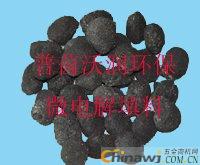**Static Experiment:**
The required equipment includes a 1L beaker, a small aeration device, micro-electrolytic filler, acid, alkali, and a coagulant. Begin by placing 1 kg of the filler into the beaker and inserting an aeration head at the bottom to create an aeration system. The wastewater to be tested is then added without filling the beaker completely. Turn on the aeration system and adjust the airflow to match the desired process conditions.
Time intervals for the test can be set at 30, 45, 60, or 90 minutes, depending on the experiment's goals. pH levels can be adjusted to 2, 3, 4, 5, or 6, and the pH of the effluent should be measured after each test. Once the reaction is complete, the wastewater is drained, and the pH is adjusted to between 8 and 9 using lime or liquid alkali. A small amount of coagulant, such as PAC, may also be added to facilitate flocculation and precipitation. The supernatant is then collected for further analysis.
**Dynamic Experiment:**
In a dynamic experiment, the setup simulates a real reactor placed on-site for continuous treatment. The reactor design can be tailored based on the type of wastewater and site conditions. Using the specific gravity of the filler (1 ton per cubic meter) and its microporosity (65%), we can calculate the treatment capacity. For example, if the micro-electrolysis process takes 60 minutes, one cubic meter of filler can treat 0.6 cubic meters of water per hour. If the process time is reduced to 30 minutes, the hourly throughput increases to 1.2 cubic meters. Similar calculations can be applied for other time intervals.
**"Iron-Carbon Filler" Experiment — Summary of Wastewater Treatment Technologies!**
1. **Printing and Dyeing Wastewater:** The micro-current and magnetic field effects between iron and carbon can break down chromophores in pollutants, effectively decolorizing the wastewater.
2. **Electroplating and PCB Wastewater, Heavy Metal Complex Wastewater:** The new ecological iron ions generated at the anode reduce heavy metal complexes. Combined with electrophoretic effects and iron hydroxide co-precipitation, this helps remove heavy metals and COD from the wastewater.
3. **Nitrobenzene, Aniline, Coking, Petrochemical, Hydrogen Peroxide, Rubber Auxiliary, and Benzene Ring Chemical Wastewater:** A 1.2V potential difference between iron and carbon generates a magnetic field that causes electron movement, breaking carbon chains and rings. This significantly reduces COD and improves biodegradability, making refractory wastewater easier to degrade.
4. **Pharmaceutical Wastewater:** The micro-current effect converts stable compounds in medical wastewater into more degradable substances, reducing COD and eliminating pathogens in hospital wastewater.
5. **Papermaking Wastewater:** With high color and pollutant content, micro-electrolysis, magnetic fields, and redox reactions convert long-chain polysaccharides into disaccharides or monosaccharides, improving biodegradability and allowing full removal via Fenton oxidation.
6. **Livestock Wastewater and High-Concentration Organic Wastewater:** Micro-electrolysis breaks down organic chains and destroys chromophoric groups, reducing COD, ammonia nitrogen, and phosphorus levels.
**"Iron Micro-Electrolysis Filler" Experiment — Detailed Data for Various Wastewaters!**
1. **Pig Farm Wastewater:** Initial COD: 12,163.05 mg/L; Ammonia Nitrogen: 1,080.16 mg/L. After small-scale denitrification tower, COD dropped to 1,790.43 mg/L; Ammonia Nitrogen to 13.28 mg/L. After micro-electrolysis, COD was 384.27 mg/L.
2. **Electroplating Wastewater:** Initial COD: 945 mg/L; After micro-electrolysis: 135 mg/L.
3. **Nitrobenzene Wastewater:** Initial COD: 3,800 mg/L; Nitrobenzene: 82.5 mg/L. After iron-carbon micro-electrolysis + Fenton: COD 107 mg/L; Nitrobenzene: 0.26 mg/L.
4. **Aniline Wastewater:** Initial COD: 5,035 mg/L; After two-stage micro-electrolysis + Fenton: COD 113 mg/L.
5. **Modified Starch Wastewater:** Initial COD: 12,000 mg/L; After two-stage micro-electrolysis: 5,875 mg/L.
6. **Cattle Wastewater:** Initial COD: 11,034 mg/L; After two-stage micro-electrolysis: 1,416 mg/L; After two-stage micro-electrolysis + Fenton: 857 mg/L. Another chemical wastewater had initial COD of 20,000 mg/L, which dropped to 1,600 mg/L after two-stage micro-electrolysis + Fenton.

Garden Lights,Garden Lights Outdoor,Garden Lights Solar
China Searun Solar Solution Co., Ltd. , https://www.srsolarlights.com